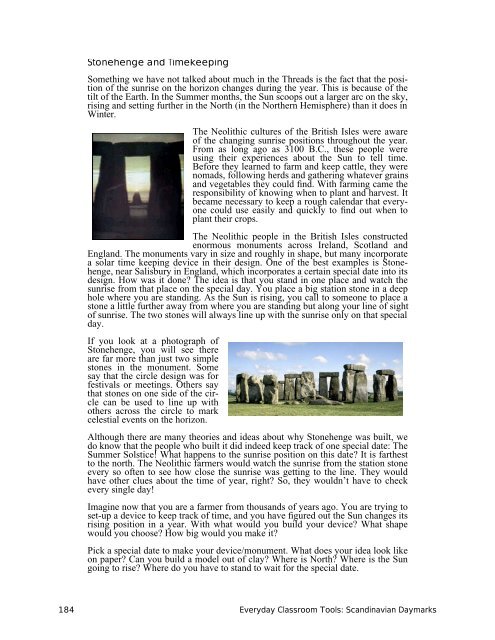Telling Time without a Clock: Scandinavian Daymarks
Telling Time without a Clock: Scandinavian Daymarks
Telling Time without a Clock: Scandinavian Daymarks
Create successful ePaper yourself
Turn your PDF publications into a flip-book with our unique Google optimized e-Paper software.
Stonehenge and <strong>Time</strong>keeping<br />
Something we have not talked about much in the Threads is the fact that the position<br />
of the sunrise on the horizon changes during the year. This is because of the<br />
tilt of the Earth. In the Summer months, the Sun scoops out a larger arc on the sky,<br />
rising and setting further in the North (in the Northern Hemisphere) than it does in<br />
Winter.<br />
The Neolithic cultures of the British Isles were aware<br />
of the changing sunrise positions throughout the year.<br />
From as long ago as 3100 B.C., these people were<br />
using their experiences about the Sun to tell time.<br />
Before they learned to farm and keep cattle, they were<br />
nomads, following herds and gathering whatever grains<br />
and vegetables they could find. With farming came the<br />
responsibility of knowing when to plant and harvest. It<br />
became necessary to keep a rough calendar that everyone<br />
could use easily and quickly to find out when to<br />
plant their crops.<br />
The Neolithic people in the British Isles constructed<br />
enormous monuments across Ireland, Scotland and<br />
England. The monuments vary in size and roughly in shape, but many incorporate<br />
a solar time keeping device in their design. One of the best examples is Stonehenge,<br />
near Salisbury in England, which incorporates a certain special date into its<br />
design. How was it done? The idea is that you stand in one place and watch the<br />
sunrise from that place on the special day. You place a big station stone in a deep<br />
hole where you are standing. As the Sun is rising, you call to someone to place a<br />
stone a little further away from where you are standing but along your line of sight<br />
of sunrise. The two stones will always line up with the sunrise only on that special<br />
day.<br />
If you look at a photograph of<br />
Stonehenge, you will see there<br />
are far more than just two simple<br />
stones in the monument. Some<br />
say that the circle design was for<br />
festivals or meetings. Others say<br />
that stones on one side of the circle<br />
can be used to line up with<br />
others across the circle to mark<br />
celestial events on the horizon.<br />
Although there are many theories and ideas about why Stonehenge was built, we<br />
do know that the people who built it did indeed keep track of one special date: The<br />
Summer Solstice! What happens to the sunrise position on this date? It is farthest<br />
to the north. The Neolithic farmers would watch the sunrise from the station stone<br />
every so often to see how close the sunrise was getting to the line. They would<br />
have other clues about the time of year, right? So, they wouldn’t have to check<br />
every single day!<br />
Imagine now that you are a farmer from thousands of years ago. You are trying to<br />
set-up a device to keep track of time, and you have figured out the Sun changes its<br />
rising position in a year. With what would you build your device? What shape<br />
would you choose? How big would you make it?<br />
Pick a special date to make your device/monument. What does your idea look like<br />
on paper? Can you build a model out of clay? Where is North? Where is the Sun<br />
going to rise? Where do you have to stand to wait for the special date.<br />
184 Everyday Classroom Tools: <strong>Scandinavian</strong> <strong>Daymarks</strong>



